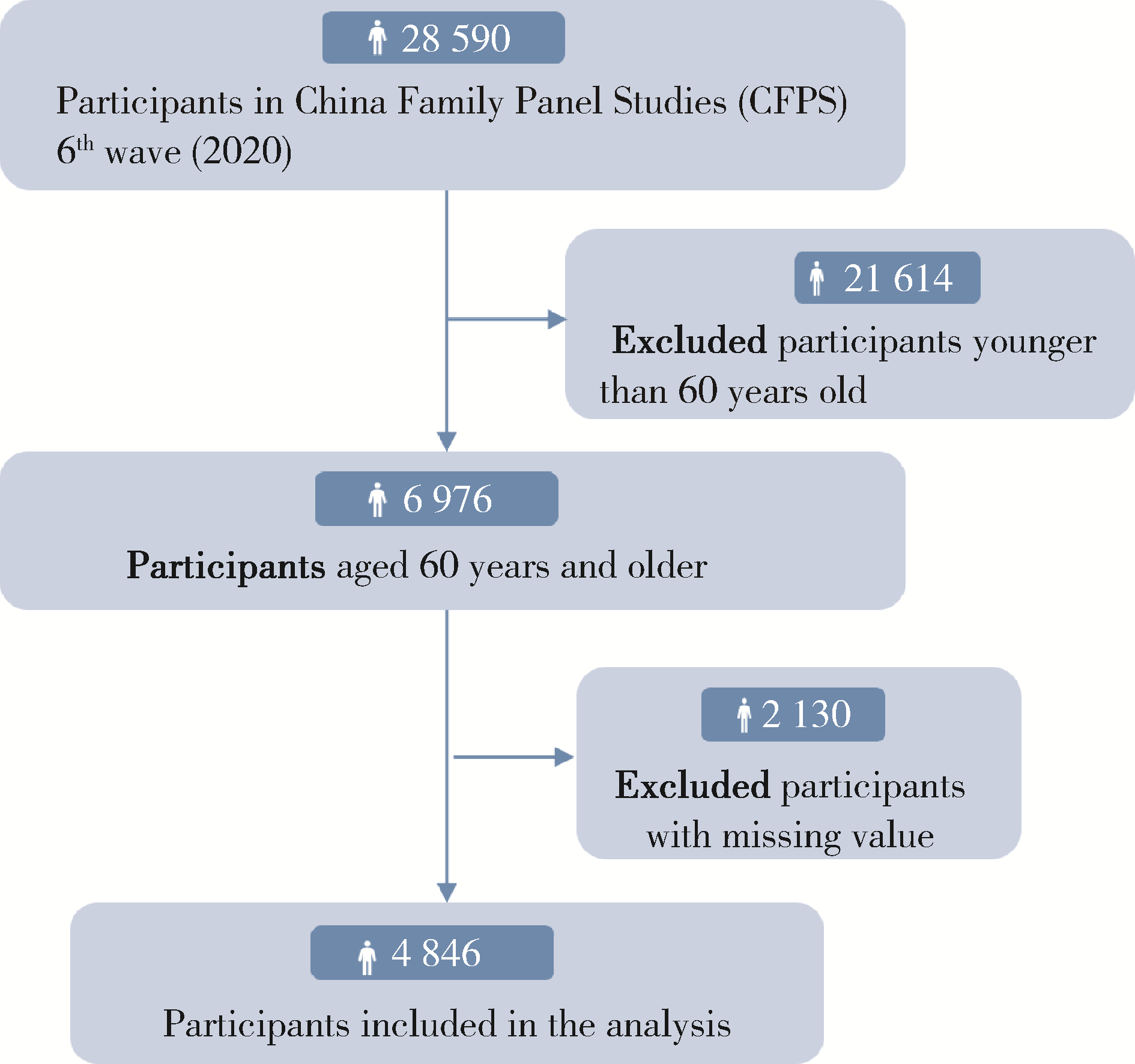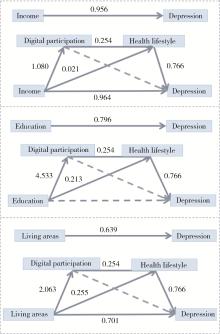北京大学学报(医学版) ›› 2024, Vol. 56 ›› Issue (2): 230-238. doi: 10.19723/j.issn.1671-167X.2024.02.005
数字融入和健康生活方式对社会经济状况与老年人抑郁关系的序列中介作用
- 1. 北京大学人口研究所,北京 100871
2. 北京大学亚太经合组织健康科学研究院,北京 100871
Sequential mediating role of digital participation and health lifestyle in the relationship between socioeconomic status and depression of older adults
Huameng TANG1,Dianqi YUAN1,Mingxing WANG1,Hanbing YANG1,Chao GUO1,2,*( )
)
- 1. Institute of Population Research, Peking University, Beijing 100871, China
2. APEC Health Science Academy (HeSAY), Peking University, Beijing 100871, China
摘要:
目的: 通过数字融入和健康生活方式的中介作用探索数字时代下社会经济状况与老年人抑郁关系的内部潜在作用机制。方法: 使用中国家庭追踪调查(China Family Panel Studies, CFPS)2020年数据,借助链式多重中介效应模型并构建健康生活方式的综合指标,运用KHB (The Karlson, Holm, and Breen)中介效应测度法检验健康生活方式和数字融入在社会经济状况与老年人抑郁之间的中介作用,计算中介作用比例,并进行结构方程模型等一系列稳健性检验。结果: 纳入分析的4 846位老年人平均年龄为(68.20±5.07)岁,其中48.06%为女性。KHB结果显示,数字融入和健康生活方式同时作为中介变量能够在社会经济地位与老年人抑郁之间起到中介作用(P < 0.000 1),健康生活方式的中介作用占比大于数字融入。本研究主要发现三条社会经济状况与老年人抑郁的潜在作用路径,包括:(1)社会经济状况→数字融入→健康生活方式→抑郁,(2)社会经济状况→健康生活方式→抑郁,(3)社会经济状况中收入和城乡对抑郁的直接作用。结构方程模型检验证明本研究模型的整体拟合情况较好。结论: 数字时代下,社会经济状况除了直接作用、以生活方式为中介间接作用于老年人抑郁,还存在通过数字融入促进形成健康的生活方式进而降低抑郁风险的序列中介作用,提示我们应关注社会经济地位较差的老年人在数字时代下多重劣势状态的进一步累积。
中图分类号:
- R749.4
| 1 | Phelan JC , Link BG , Tehranifar P .Social conditions as fundamental causes of health inequalities: Theory, evidence, and policy implications[J].J Health Soc Behav,2010,51(Suppl):S28-S40. |
| 2 |
Cockerham WC .Health lifestyle theory and the convergence of agency and structure[J].J Health Soc Behav,2005,46(1):51-67.
doi: 10.1177/002214650504600105 |
| 3 |
de Vogli R , Gimeno D , Kivimaki M .Socioeconomic inequalities in health in 22 European countries[J].New Engl J Med,2008,359(12):1290-1291.
doi: 10.1056/NEJMc081414 |
| 4 |
van Doorslaer E , Koolman X .Explaining the differences in income-related health inequalities across European countries[J].Health Econ,2004,13(7):609-628.
doi: 10.1002/hec.918 |
| 5 |
Meyer IH , Schwartz S , Frost DM .Social patterning of stress and coping: Does disadvantaged social statuses confer more stress and fewer coping resources[J].Soc Sci Med,2008,67(3):368-379.
doi: 10.1016/j.socscimed.2008.03.012 |
| 6 | 王甫勤.社会经济地位、生活方式与健康不平等[J].社会,2012,32(2):125-143. |
| 7 | 黄洁萍, 尹秋菊.社会经济地位对人口健康的影响——以生活方式为中介机制[J].人口与经济,2013,(3):26-34. |
| 8 | 袁迎春.不平等的再生产: 从社会经济地位到健康不平等——基于CFPS2010的实证分析[J].南方人口,2016,31(2):1-15. |
| 9 |
Jones IR , Papacosta O , Whincup PH , et al.Class and lifestyle "lock-in" among middle-aged and older men: A multiple correspondence analysis of the British regional heart study[J].Sociol Health Ill,2011,33(3):399-419.
doi: 10.1111/j.1467-9566.2010.01280.x |
| 10 | 唐丹, 张琨, 亓心茹.互联网使用对老年人社会网络及孤独感的影响: 基于用途的分析[J].人口研究,2022,46(3):88-101. |
| 11 |
Cotten SR , Ford G , Ford S , et al.Internet use and depression among older adults[J].Comput Hum Behav,2012,28(2):496-499.
doi: 10.1016/j.chb.2011.10.021 |
| 12 |
Confortin SC , Giehl MWC , Antes DL , et al.Positive self-rated health in the elderly: A population-based study in the South of Brazil[J].Cad Saude Publica,2015,31(5):1049-1060.
doi: 10.1590/0102-311X00132014 |
| 13 |
Gracia E , Herrero J .Internet use and self-rated health among older people: A national survey[J].J Med Internet Res,2009,11(4):e49.
doi: 10.2196/jmir.1311 |
| 14 | 王宇.智能手机使用对老年人主观健康的影响研究——基于2016年中国老年社会追踪调查(CLASS)数据[J].人口与发展,2020,26(6):65-75. |
| 15 | 李志光, 贾仓仓.互联网使用对中老年人心理健康的影响: 异质性特征与作用机制检验[J].江苏社会科学,2021,(6):72-79. |
| 16 | 杜鹏, 马琦峰, 和瑾, 等.互联网使用对老年人心理健康的影响研究——基于教育的调节作用分析[J].西北人口,2023,44(2):1-13. |
| 17 |
Chang SJ , Im EO .A path analysis of Internet health information seeking behaviors among older adults[J].Geriatr Nurs,2014,35(2):137-141.
doi: 10.1016/j.gerinurse.2013.11.005 |
| 18 |
Wang YN , Song YT , Zhu YR , et al.Association of eHealth literacy with health promotion behaviors of community-dwelling older people: The chain mediating role of self-efficacy and self-care ability[J].Int J Env Res Pub Health,2022,19(10):6092.
doi: 10.3390/ijerph19106092 |
| 19 |
Nakagomi A , Shiba K , Kawachi I , et al.Internet use and subsequent health and well-being in older adults: An outcome-wide analysis[J].Comput Hum Behav,2022,130,107156.
doi: 10.1016/j.chb.2021.107156 |
| 20 |
Peng YI , Chan YS .Do internet users lead a healthier lifestyle?[J].J Appl Gerontol,2020,39(3):277-284.
doi: 10.1177/0733464818785797 |
| 21 | 阮航清, 陈功.中国老年人与收入相关的健康不平等及其分解——以北京市为例[J].人口与经济,2017,(5):84-94. |
| 22 | 赵晓航, 阮航清.中国成年人抑郁症状的社会经济梯度研究——基于"中国家庭追踪调查"2014年和2016年数据[J].北京社会科学,2019,(8):34-47. |
| 23 | 伍小兰, 李晶, 王莉莉.中国老年人口抑郁症状分析[J].人口学刊,2010,(5):43-47. |
| 24 | 李甲森, 马文军.中国中老年人抑郁症状现状及影响因素分析[J].中国公共卫生,2017,33(2):177-181. |
| 25 | 丁志宏, 王妍.使用互联网会降低老年人的抑郁水平吗?[J].兰州学刊,2023,(2):148-160. |
| 26 |
Zheng X , Guo C .Strengthening systematic research on aging: Reflections from an omics perspective[J].China CDC Wkly,2022,4(39):875-878.
doi: 10.46234/ccdcw2022.181 |
| 27 | 张韵, 梁宏.社会经济地位与老年人生活方式: 低水平的"收敛"与高水平的"发散"[J].人口研究,2021,45(3):114-128. |
| 28 |
Briggs R , Carey D , O'Halloran AM , et al.Validation of the 8-item centre for epidemiological studies depression scale in a cohort of community-dwelling older people: data from The Irish Longitudinal Study on Ageing (TILDA)[J].Eur Geriatr Med,2018,9(1):121-126.
doi: 10.1007/s41999-017-0016-0 |
| 29 |
Zhan HJ , Feng XT , Luo BZ .Placing elderly parents in institutions in urban China: A reinterpretation of filial piety[J].Res Aging,2008,30(5):543-571.
doi: 10.1177/0164027508319471 |
| 30 | 骆琪, 阎国光.社会经济地位对老年人健康影响的实证检验[J].统计与决策,2012,(13):91-94. |
| 31 | 齐良书, 王诚炜.健康状况与社会经济地位: 基于多种指标的研究[J].中国卫生经济,2010,29(8):47-50. |
| 32 |
Wu XG , Treiman DJ .The household registration system and social stratification in China: 1955-1996[J].Demography,2004,41(2):363-384.
doi: 10.1353/dem.2004.0010 |
| 33 | 程云飞, 李姝, 熊晓晓, 等."数字鸿沟"与老年人自评健康——以北京市为例[J].老龄科学研究,2018,6(3):14-25. |
| 34 | 张未平, 范君晖.老年数字鸿沟的社会支持体系构建[J].老龄科学研究,2019,7(2):63-70. |
| 35 | 李路路, 王煜."健康"作为生活方式的模式: 机会结构和个体能动性的双重建构——基于潜类别分析的研究[J].江苏社会科学,2018,(5):70-81. |
| 36 |
Sun YJ , Xu LZ , Ma ZH , et al.Health-related risky behaviors and their risk factors in adolescents with high-functioning autism[J].World J Clin Cases,2021,9(22):6329-6342.
doi: 10.12998/wjcc.v9.i22.6329 |
| 37 |
Zhang L , Bi XY , Ding ZH .Health lifestyles and Chinese oldest-old's subjective well-being-evidence from a latent class analysis[J].Bmc Geriatrics,2021,21(1):206.
doi: 10.1186/s12877-021-02121-0 |
| 38 | 唐丹.城乡因素在老年人抑郁症状影响模型中的调节效应[J].人口研究,2010,34(3):53-63. |
| 39 | 柳士顺, 凌文辁.多重中介模型及其应用[J].心理科学,2009,32(2):433-435. |
| 40 | 温忠麟, 叶宝娟.中介效应分析: 方法和模型发展[J].心理科学进展,2014,22(5):731-745. |
| 41 |
Preacher KJ , Hayes AF .Asymptotic and resampling strategies for assessing and comparing indirect effects in multiple mediator models[J].Behav Res Methods,2008,40(3):879-891.
doi: 10.3758/BRM.40.3.879 |
| 42 |
Breen R , Karlson KB , Holm A .Total, direct, and indirect effects in Logit and probit models[J].Sociol Methods Res,2013,42(2):164-191.
doi: 10.1177/0049124113494572 |
| 43 |
Kohler U , Karlson KB , Holm A .Comparing coefficients of nested nonlinear probability models[J].Stata J,2011,11(3):420-438.
doi: 10.1177/1536867X1101100306 |
| 44 | 程开明.结构方程模型的特点及应用[J].统计与决策,2006,(10):22-25. |
| 45 |
Cotten SR , Ford G , Ford S , et al.Internet use and depression among retired older adults in the United States: A longitudinal analysis[J].J Gerontol B Psychol Sci Soc Sci,2014,69(5):763-771.
doi: 10.1093/geronb/gbu018 |
| 46 | 王雪辉, 彭聪.老年人社会经济地位对健康的影响机制研究——兼论生活方式、公共服务和社会心理的中介效应[J].中国卫生政策研究,2020,13(3):21-30. |
| 47 | 薛新东, 葛凯啸.社会经济地位对我国老年人健康状况的影响——基于中国老年健康影响因素调查的实证分析[J].人口与发展,2017,23(2):61-69. |
| 48 | 杨梦瑶, 李知一, 李黎明.互联网使用与老年人的心理健康——基于两级数字不平等的视角[J].人口与发展,2022,28(6):132-147. |
| 49 |
Dannefer D .Cumulative advantage/disadvantage and the life course: Cross-fertilizing age and social science theory[J].J Gerontol B Psychol Sci Soc Sci,2003,58(6):S327-S337.
doi: 10.1093/geronb/58.6.S327 |
| 50 |
Yates S , Kirby J , Lockley E .Digital Media Use: Differences and inequalities in relation to class and age[J].Sociol Res Online,2015,20(4):1-21.
doi: 10.5153/sro.3810 |
| 51 | 杜本峰, 王旋.老年人健康不平等的演化、区域差异与影响因素分析[J].人口研究,2013,37(5):81-90. |
| 52 | 赵万里, 谢榕.数字不平等与社会分层: 信息沟通技术的社会不平等效应探析[J].科学与社会,2020,10(1):32-45. |
| 53 |
Norman CD , Skinner HA .eHealth literacy: Essential skills for consumer health in a networked world[J].J Med Internet Res,2006,8(2):e9.
doi: 10.2196/jmir.8.2.e9 |
| 54 |
Hall AK , Bernhardt JM , Dodd V , et al.The digital health divide: Evaluating online health information access and use among older adults[J].Health Educ Behav,2015,42(2):202-209.
doi: 10.1177/1090198114547815 |
| 55 |
Suka M , Odajima T , Okamoto M , et al.Relationship between health literacy, health information access, health behavior, and health status in Japanese people[J].Patient Educ Couns,2015,98(5):660-668.
doi: 10.1016/j.pec.2015.02.013 |
| 56 | 陆杰华, 韦晓丹.老年数字鸿沟治理的分析框架、理念及其路径选择——基于数字鸿沟与知沟理论视角[J].人口研究,2021,45(3):17-30. |
| 57 | 王元超, 王夏雨.互联网对个人健康的积极影响及其形成机制: 社会关系网络的作用[J].华东理工大学学报(社会科学版),2022,37(1):66-80. |
| 58 | 赵建国, 刘子琼.互联网使用对老年人健康的影响[J].中国人口科学,2020,(5):14-26. |
| [1] | 王敏, 李倩. 青少年抑郁症患者心理弹性影响因素的路径分析[J]. 北京大学学报(医学版), 2024, 56(5): 809-814. |
| [2] | 刘园梅, 傅义程, 郝靖欣, 张福春, 刘慧琳. 老年髋部骨折患者住院期间发生术后心力衰竭的列线图预测模型的构建及验证[J]. 北京大学学报(医学版), 2024, 56(5): 874-883. |
| [3] | 陈敬,单蕊,肖伍才,张晓蕊,刘峥. 青春期和成年早期自制力与抑郁症状和超重肥胖共病风险的关联:基于全国调查的十年前瞻性队列研究[J]. 北京大学学报(医学版), 2024, 56(3): 397-402. |
| [4] | 张浩宇,石逸雯,潘薇,刘爱萍,孙昕霙,李曼,张旭熙. 基于不同失能水平的老年人照料需求的影响因素[J]. 北京大学学报(医学版), 2024, 56(3): 431-440. |
| [5] | 靖婷,江华,李婷,申倩倩,叶兰,曾银丹,梁文欣,冯罡,司徒文佑,张玉梅. 中国西部5城市中老年人血清25羟基维生素D与握力的相关性[J]. 北京大学学报(医学版), 2024, 56(3): 448-455. |
| [6] | 林郁婷,王华丽,田宇,巩俐彤,常春. 北京市老年人认知功能的影响因素[J]. 北京大学学报(医学版), 2024, 56(3): 456-461. |
| [7] | 刘慧丽,吕彦函,王晓晓,李民. 老年患者腹腔镜泌尿系肿瘤根治术后慢性疼痛的影响因素[J]. 北京大学学报(医学版), 2023, 55(5): 851-856. |
| [8] | 赖金惠,王起,姬家祥,王明瑞,唐鑫伟,许克新,徐涛,胡浩. 新型冠状病毒肺炎疫情期间延迟拔除输尿管支架对泌尿系结石术后患者生活质量和心理状态的影响[J]. 北京大学学报(医学版), 2023, 55(5): 857-864. |
| [9] | 祝春素,连至炜,崔一民. 中国中老年人抑郁和慢性病的关联[J]. 北京大学学报(医学版), 2023, 55(4): 606-611. |
| [10] | 王婷,李乔晟,刘皓冉,简伟研. 人格特征、城乡差异与抑郁症状变化的关系[J]. 北京大学学报(医学版), 2023, 55(3): 385-391. |
| [11] | 袁雯,张奕,陈力,蒋家诺,陈曼曼,刘婕妤,马涛,马奇,崔孟杰,郭桐君,王鑫鑫,董彦会,马军. 儿童青少年身体脂肪分布与抑郁和社交焦虑的关联:基于双能X线检测的横断面研究[J]. 北京大学学报(医学版), 2023, 55(3): 429-435. |
| [12] | 张紫薇,花语蒙,刘爱萍. 中国中老年人群抑郁症状、缺血性心血管疾病10年风险对心血管疾病的联合影响[J]. 北京大学学报(医学版), 2023, 55(3): 465-470. |
| [13] | 陆林,刘晓星,袁凯. 中国脑科学计划进展[J]. 北京大学学报(医学版), 2022, 54(5): 791-795. |
| [14] | 刘光奇,庞元捷,吴疆,吕敏,于孟轲,李雨橦,黄旸木. 2013—2019年流感季北京市住院老年人流感疫苗接种趋势分析[J]. 北京大学学报(医学版), 2022, 54(3): 505-510. |
| [15] | 刘杰,郭超. 正/负性情绪对中国老年人死亡风险影响的前瞻性队列研究[J]. 北京大学学报(医学版), 2022, 54(2): 255-260. |
|
||






